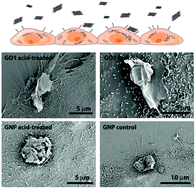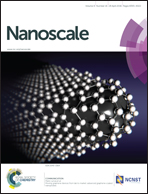Interaction of graphene-related materials with human intestinal cells: an in vitro approach†
Abstract
Graphene-related materials (GRM) inherit unique combinations of physicochemical properties which offer a high potential for technological as well as biomedical applications. It is not clear which physicochemical properties are the most relevant factors influencing the behavior of GRM in complex biological environments. In this study we have focused on the interaction of GRM, especially graphene oxide (GO), and Caco-2 cells in vitro. We mimiked stomach transition by acid-treatment of two representative GRM followed by analysis of their physicochemical properties. No significant changes in the material properties or cell viability of exposed Caco-2 cells in respect to untreated GRM could be detected. Furthermore, we explored the interaction of four different GO and Caco-2 cells to identify relevant physicochemical properties for the establishment of a material property–biological response relationship. Despite close interaction with the cell surface and the formation of reactive oxygen species (ROS), no acute toxicity was found for any of the applied GO (concentration range 0–80 μg ml−1) after 24 h and 48 h exposure. Graphene nanoplatelet aggregates led to low acute toxicity at high concentrations, indicating that aggregation, the number of layers or the C/O ratio have a more pronounced effect on the cell viability than the lateral size alone.


 Please wait while we load your content...
Please wait while we load your content...